Spirited Animation is many things in the Jones household—it’s a combination of the two realms in which we are experts (spirituality and Animation Studies); it’s a formalized space for conversations and debates we were already having; and it’s a way for us to engage more deeply in the media we watch with our kids, trusting that there are indeed deeper lessons for us and for them. We started the podcast earlier this year thinking it would be a fun project for us, and have been pleasantly surprised with how it has resonated with others and how the Spirit has revealed deeper possibilities for what it might mean than we could have ever expected.
When people wonder why we would explore this intersection of spirituality and animation, our first reaction is simply that animated media provides a seemingly endless range of different kinds of stories—at once both accessible and rewarding further consideration. Taking stories apart to discover deeper meanings is reminiscent of the way Jesus himself taught and created space for reflection. The parables of Jesus took place with unexpected characters (widows, beggars, dishonest judges, etc) in unexpected settings (fields, the Jericho Road, rocky cliffs) in order to expand the hearer’s understanding and experience of the divine. The Church has cherished these stories for millenia, knowing that a story well told yields layers and layers of understanding that we can explore and discuss to deepen our knowledge and experience of the Divine.
Animation is similarly both familiar and hidden. At its simplest it describes the creation of movement, what Disney animators Frank Thomas and Ollie Johnston famously popularized as the “illusion of life.” Such movement is found in some of the earliest known works of art, and through human ingenuity now features in almost every aspect of our lives, from entertainment for children and adults, to the technologies we use to interact with and visualize our world every day. This familiarity creates unique challenges, so easily taken for granted, mistaking our human fascination with life-giving images and stories for mere fantasy or escapism from other spheres of life and community. Instead, we consider how this shared experience inspires and connects us across boundaries and categories other forces in society try to force upon us.
By engaging in these stories and this medium of expression with an eye to how they might yield deeper lessons, we create space for those unfamiliar with or harmed by how the Church has used scripture in the past. Animated media and the ways it tells stories provide entry points into discussions around community, spirituality, and identity that may not be possible in more traditional “church” spaces. It also allows us to have conversations across boundaries that have typically left many people out. Engaging in spiritual practices with animated media creates space for intergenerational conversations, because our kids can more easily understand and have their own thoughts and feelings about an animated story than they can about an ancient and inaccessible scripture. It creates space for interfaith and seeker-friendly conversations because we are not assuming a Christian vocabulary, but rather engaging simply with the media in front of us.
One example of how our discussions work is in our upcoming episode on An American Tail. This movie, directed by Don Bluth, was dear to both of us as kids. When we decided to add it to our schedule, we were hopeful that it would hold up, and still speak to us 30 years later, and were delighted that it did! Not every animated movie will stand that test of time, but ones that are well-crafted and telling good stories will.

Tim’s perspective on this movie is deeply shaped by his own story of immigrating to the United States from England as a child not much older than Fievel, the main character. In our discussion, we reflect on where his experience mirrored the movie, where it differed, and where the “cracks” in the American Dream were apparent even as children. We also talk about what the movie teaches us about allyship as non-immigrants and how we would want to present our own stories, Fievel’s story, and stories about America to our kids. This simple, short animated movie packs a lot of food for thought in what many would write off as simply a “kids’ movie about a mouse.” Our hope in making this podcast is to give space for these stories and this medium to reach an ever-widening audience that recognizes the ways in which they hold much deeper potential than what larger society gives them credit for.
Ultimately, we have these conversations and make this podcast knowing that such reflections cannot stay in a bubble. Just like Jesus told parables to spur the disciples into action and deeper understanding, so too does engaging deeply with animated media. As we discussed Fievel’s story of immigration and the complicated nature of the American Dream, in real time we remembered that our Church offers resources to more deeply engage those topics (Check out a clip here!). Connecting An American Tail to the work of Lutheran Immigrant and Refugee Services (LIRS) gives us and our listeners a tangible way to respond to the ways the Spirit moves in us through Fievel’s story. The compassion we feel for him and his family can be channeled into real people and meeting real needs – just like the story of the Good Samaritan is meant to move us to action and care for our actual neighbors and those in need.
And while each movie or show takes us to different topics and moves us to connect in different ways, we always come back to our core reason for making this podcast, which is our kids. Rather than shy away from animation’s popular association with childhood—or even animation created only for adults—we recognize that animation is both/and. It connects us. Accordingly, each episode we have a “Parenting Corner” for us to intentionally think about either the lessons the movie gives us as parents, or what lessons we hope our kids take away from it. This gives us a framework not only for a sort of “liturgy” and structure to the podcast, but also for how we engage with media. Engaging with movies and TV shows with this mindset feels a lot like engaging with the stories of scripture and the movements of our faith. In both spheres we are asking ourselves, “How does this shape us and our kids for the good of others and the good of the world?” And, like scriptural study, we are very rarely left with the “right” answer, or even one definitive answer, but are rather invited into deeper reflection and engagement with one another and the Divine.
We’re still in the very early stages of discovering what the potential of opening up this space for discussion and spiritual practice in this new way might yield. We have already seen its impact in our relationship and parenting, and have hope that by inspiring “spirited conversations” in other’s lives, we might be riding the wave of the Holy Spirit to create a community in ways we never would have anticipated before. We hope you listen (and like and subscribe!) and join us wherever the Spirit is going!






